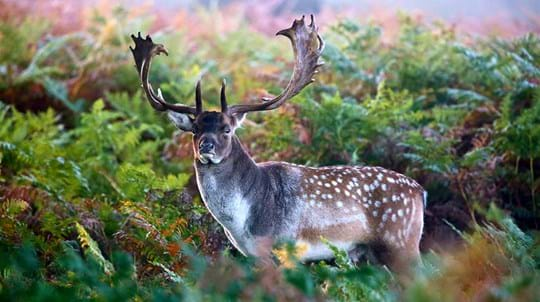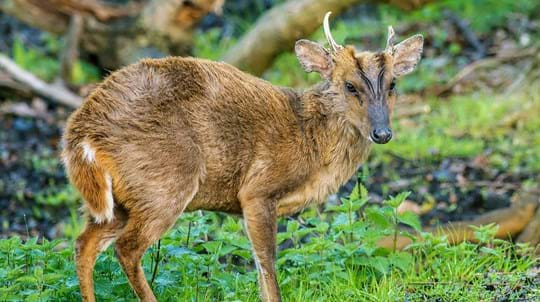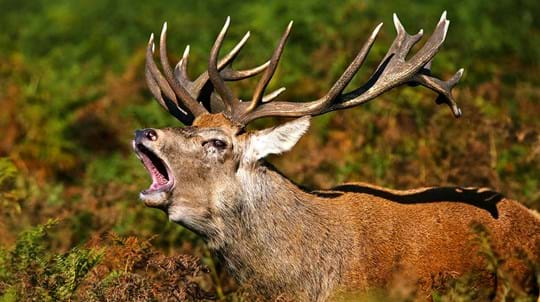
What do deer eat? What are antlers made of? And more deer facts
James Martin • 03 May 2019
From the dainty muntjac to the mighty red stag, the UK is home to six species of wild deer. Learn more about these fascinating creatures.
Read the blogNimble and fleet of foot. The roe is our most widely distributed deer, found in woods across the country. Look out for its white rump flashing as it acrobatically bounds through the trees.
Common name: roe deer
Scientific name: Capreolus capreolus
Family: Cervidae (deer)
Habitat: woodland, farmland, occasionally urban areas
Diet: tree shoots, leaves, herbs and brambles
Predators: adults have no natural predators; young are occasionally taken by foxes
Origin: native
The appearance of roe deer changes throughout the year. They have bright red-brown fur in summer, fading to a duller shade of brown in winter. Adult males, known as bucks, have small antlers with up to three points which they shed and regrow each year. Both sexes have black noses, a white chin and white rump.
Roe deer are browsers and will feed on tree shoots and leaves, herbs, brambles, ivy and other woody plants.

James Martin • 03 May 2019
From the dainty muntjac to the mighty red stag, the UK is home to six species of wild deer. Learn more about these fascinating creatures.
Read the blogIn the original children’s books, the character Bambi was a roe deer.
The mating season occurs in summer, with bucks entering the rut and fighting for access to females (known as does) during July and August. After fighting off its rivals, a buck will then chase a doe for some time until she is ready to mate. Once mating has occurred, the female will typically give birth to two or three young in late spring or early summer the following year.
Known as kids or fawns, the young are born with a spotted coat to provide camouflage from predators. For the first few months of their lives, the kids are left hidden in long grass and only visited by their mother for short periods to suckle. They then begin to accompany their mother before eventually setting out to find a territory of their own.

Credit: Steve Roach / WTML
Roe deer are found throughout mainland Britain, but are absent from Ireland. The highest numbers occur in Scotland and southern England. They are primarily a woodland species, but will venture out into fields and farmland to feed. They can sometimes be seen in urban green spaces, such as cemeteries and golf courses, provided there is cover to hide in and limited disturbance from humans.

Credit: Amy Lewis / WTML
Walk quietly through the woods and you have a chance of encountering a roe deer. If you spot it from a distance it may stand and observe you for a short while before moving off. Take a roe by surprise and it will bound away with its white rump flashing. It may even make a barking alarm sound.
Roe deer have been recorded running at up to 37 miles per hour.
The UK is home to six deer species, but only the roe and red deer are native. By the 19th century, roe deer had disappeared from most of the UK, surviving only in Scotland and isolated pockets elsewhere. Reintroductions from Europe and positive habitat change helped the species recover and it is now abundant.
While the recovery of the species is welcome, the absence of large carnivores in the UK means adult roe deer have no natural predators. Consequently, deer density can reach extremely high levels, with total deer numbers in the UK thought to be at a 1,000-year high. This can have a significant negative impact on the environment, with overgrazing preventing the regeneration of woodland, thereby affecting woodland structure and tree species composition. This has knock-on effects for other species of woodland flora and fauna. For this reason, some deer populations are culled to control their spread and reduce habitat damage.

Trees woods and wildlife
A social, elegant species with a signature speckled coat and mighty palmate antlers. The non-native fallow deer is now a regular sight in UK woodland. Find out what it eats, how it breeds and how to spot it.

Trees woods and wildlife
Small and secretive. Muntjac are an attractive, but potentially damaging, addition to our woodlands. Find out what they look like, what they eat and where they live.

Trees woods and wildlife
The majestic monarch of the glen. Our largest land mammal, red deer, are the royalty of UK woodland. Learn all about them, from what they eat to where they live and how to identify them.